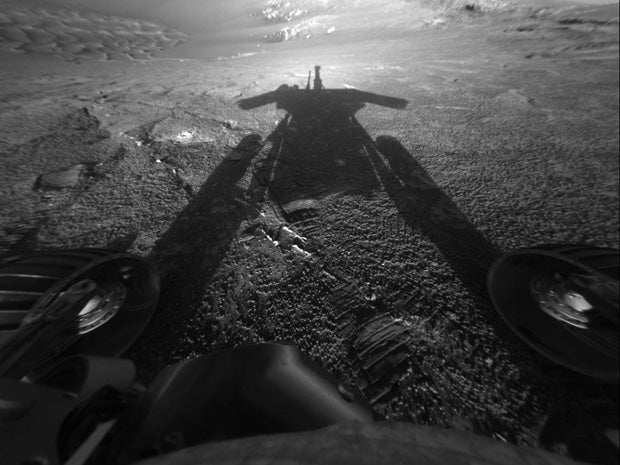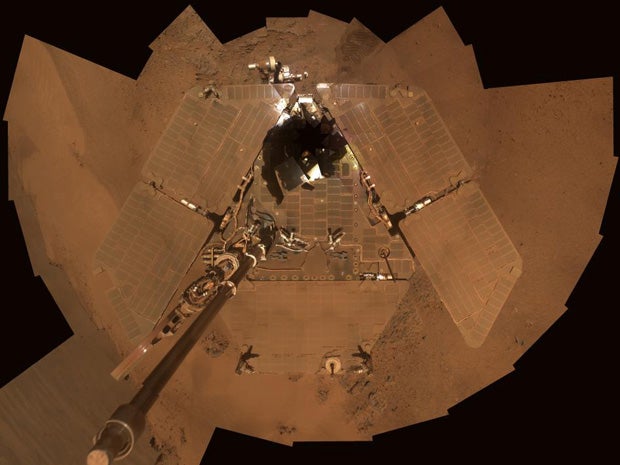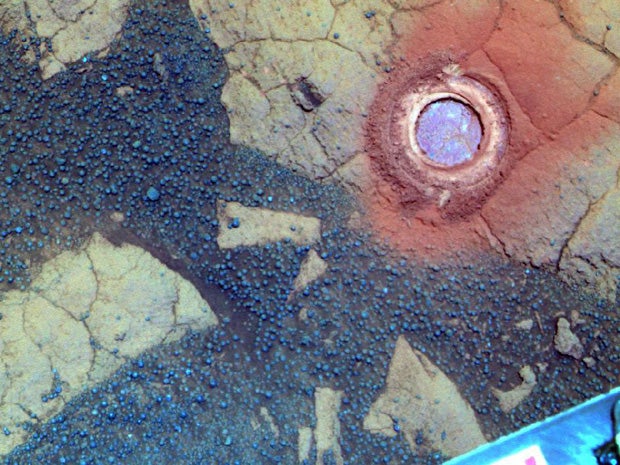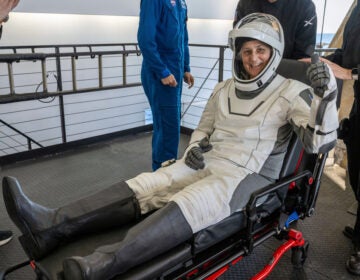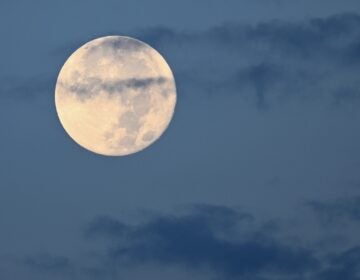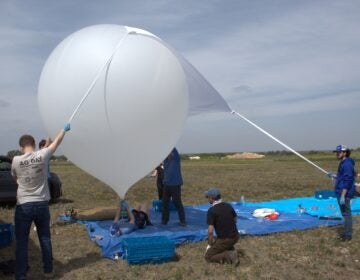The intrepid Mars Rover Opportunity rolls on
ListenOpportunity has traversed 22.2 miles in its nine years and four months on the Red Planet, and is still performing good science. Jupiter, Venus, Mercury appear to cluster together in the night sky this evening, before slowly drifting apart on subsequent nights. Come Friday, a good sized asteroid will make its closest approach to Earth for the next 200 years.
May 27, 2013
[Dave Heller] If slow and steady wins the race, the Mars Rover Opportunity gets the blue ribbon. Joining me to bestow the award is Derrick Pitts, chief astronomer at the Franklin Institute. Now Derrick, let’s see, it landed on the red planet January 25, 2004, some nine years, four months ago — how far has it gotten?
[Derrick Pitts] In all that time, it has managed to beat this incredible record of travel across an extraterrestrial surface, travelling a total of 22.22 miles.
Well gosh, that’s most of a marathon.
Yeah it seems like it’s not too big of a deal when you consider that a marathon is 26.2 miles. In this case though, for a rover like this, it really is an enormous distance. Travelling on the surface of Mars these last nine years in the environment, with the equipment it has, the difficulties it’s faced, it really is a remarkable trip.
What are some of the highlights over that nine-year trek?
I think probably one of the greatest highlights is the confirmation that water existed on Mars in the past. And not just a little water, but a lot of water. By the discovery of particular minerals in the locations where it’s been that indicate that liquid water was indeed on Mars. Now, we know that over the time that we have been talking about Spirit and Opportunity and the current rover in the Mars Science Laboratory, we know that different kinds of evidence of the existence of water have been discovered and identified. But the rovers Opportunity and Spirit were the ones that really nailed the point about Mars actually having been warmer and wetter in the past.
Of course the next generation is also actively scouring the planet; is Opportunity still doing good science, or is it in semi-retirement?
After nine years, when you consider that its original mission was only supposed to be 90 days, you would expect that it would certainly be into retirement, lounging on a beach somewhere, playing golf every other day or so. But indeed this rover turns out to be just fine. There doesn’t seem to be very much wrong with it at all, and it’s still doing science. In fact, just a few sols ago, that would be Mars days ago, the rock abrasion tool was still at the job of drilling holes in different rocks to discover new mineral types and things of this sort, so all of its tools seem to still be working, its communication system is just fine, its still sending pictures back. And remember we just mentioned a moment ago, this rover’s main mission was completed in 90 days. Its lifetime, its life mission was expected to be 90 days, it’s now nine years later.
Slideshow below: Photos from Mars Rover Opportunity. Photo credits: NASA
Kudos to NASA and the folks in technology that keeps that all together. Hey Derrick, I have the five-day forecast here, it’s calling for the winds to kick up Friday afternoon.
Yeah, it’s going to be a little bit breezy here on Friday afternoon. The breeze you’re talking about, of course, comes from an asteroid that will be passing Earth this Friday. Now we needn’t worry as much as we worried about the last asteroid passage we knew about in February; that was an asteroid that was passing within 17,500 miles of Earth, that’s the one that occurred on that Friday afternoon where that morning another asteroid crashed onto the surface of Earth in central Russia. But this one, 1.7 miles in size, is going to be 3.6 million miles away from Earth; not really worth worrying about at all, as far as any impact possibilities — fifteen times the distance from the Earth to the moon, so it’s a long way out there. However, it’s a really good indicator of how scientists are able to keep track of the large asteroids that we need to pay the most attention to.
Now how does this one compare to the meteor that struck the moon last week?
This one is much, much, much bigger. Orders of magnitude larger even at 1.7 miles, so that’s an indication of how small the other one was, it really was quite small. But you know, when you look at what the effects were of what we saw with the impact of that object that was reported last week, you know the bright flash that we saw, we always have to remember that it’s not just the size that counts, but it’s the velocity at which it’s travelling that turns into the energy that creates the bright flash that we may see. So even though the one that struck the moon was really quite small, the speed of the impact helped it appear a lot brighter.
“We always have to remember that it’s not just the size that counts, but it’s the velocity at which [meteors are] travelling that turns into the energy that creates the bright flash that we may see.”
Derrick Pitts
-
Bright explosion on the moon can be seen from Earth
OK, now we’ve got the daytime sky covered, what’s happening at night this week?
In the evening, 45 minutes after sunset tonight, it’s a great time to get out and catch three planets doing their thing together over in the northwestern sky: Jupiter, Venus and Mercury. Two of the brightest planets in the solar system and the most elusive planet in the solar system are all perfectly placed together for easy view. If you got out to a place where you have a clear view of the western horizon, low on the northwestern horizon with a pair of binoculars you’ll be able to see all three. Jupiter and Venus will be readily apparent, because Venus is the brightest of the three followed by Jupiter. Mercury, of course, is the smallest but it also has a good brightness to it, it’s just difficult to see because of its small size.
With a naked eye though, will they still look distinct, or blurred into a single image?
No, they will still look distinct. If they were blurred into a single image, if they were close enough to appear as a single image, that would really be a remarkable incidence of co-alignment of all three of these. And that is indeed very, very, very rare because of the orbital tilt of the planets, the position, the motion, all those things, all those factors would make that difficult. But just to have them all so close together really is good.
So for example, Jupiter tonight will be just two degrees south of Mercury. So if you can find Jupiter, all you have to do is look just a little bit to the north of Jupiter and you’ll be able to see Mercury. But Venus will be between the two. So the way you’re viewing this as you look out onto the horizon is Jupiter will be closest to the horizon, Venus will be just above, and then Mercury just above that. In order of brightness what you’ll see is Venus will be the brightest, Jupiter below and Mercury above Venus. So it’s easy to catch these if we have a clear sky that we can see this from.
WHYY is your source for fact-based, in-depth journalism and information. As a nonprofit organization, we rely on financial support from readers like you. Please give today.


